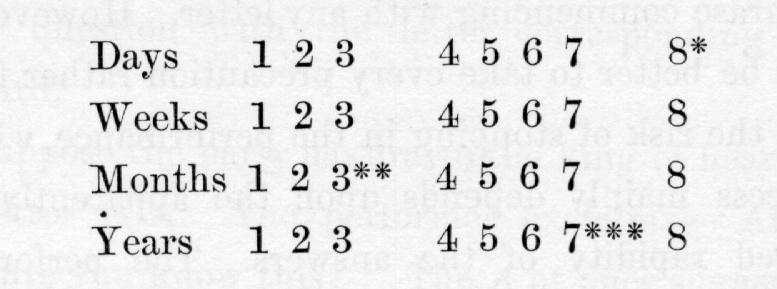| The gaming table : its votaries and victims, in all times and countries,
especially in England and in France. Vol. 2 | ||
15. The mystery of double sight.
All the cards of a pack, or indeed any common object touched by a spectator, may be named by an assistant in the following way — whilst in another apartment, or blindfolded.
Take 32 cards and arrange them in four lines, one under
the other. You arrange with your assistant to name the first
line after the days of the week; the second will represent
the weeks, the third the months, the fourth the
years. The assistant is enjoined to count the days aloud,
and the first card by the left. The following is the entire
scheme: —
 [Description: Scheme for double sight trick]
[Description: Scheme for double sight trick]
The cards being thus arranged, the party who has to guess them retires from the room. When
Suppose the card touched be one of those marked with the asterisks * ** ***; if it be the first, the associate says,; I give him eight days to guess it.' Then the medium, beginning with the upper line, that of the days, will at once be able to say that the card touched is the eighth of the first horizontal line, or the first of the eighth vertical line.
If it be the card holding the place of the number marked with two asterisks ** the associate says `three months,' and `seven years' for the one marked with three asterisks ***.
Thus, whatever card is touched, it will be easy to indicate it, by beginning with the line of days at the top, counting one from the left of the associate and medium.
Such is the simple process; and the following is the conventional catechism adopted by all the
With this collection of words and phrases, every existing object can be guessed, provided care be taken to classify them according to the following indications.
To operate, two persons must establish a perfect
understanding between them. One undertakes the questions, the
other the answers, the latter having his eyes perfectly
blindfolded. Both of them must thoroughly know the following
numbers with their correspondences: —
- 1. Now.
- 2. Answer or reply.
- 3. Name.
- 4. What is the object, or thing.
- 5. Try.
- 6. Again.
- 7. Instantly.
- 8. Which?
- 9. Quick.
- 10. Say.
- 20. Tell me.
- 30. I request you.
- 40. Will you.
- 50. Will you (to) me.
- 60. Will you (to) us.
Example: — Add the question of the simple number to the question of the decade or ten. Thus, in pronouncing the words `Say now,' 11 — for say is 10, and now is 1, total 11. This, therefore, forms question 11.
Again — `Tell me which number,' 28 — for `tell me' is 20, and `which' is 8, total 28.
Thirdly: — `I request you instantly,' 37; for `I request you' is 30, and `instantly' is 7, total 37.
All the expressions or words that follow are totally independent of the answer, and are only adapted to embellish or mystify the question as far as the audience is concerned. For instance:
Question 7. Instantly, what I have in my hand? Answer, A watch.
Question 9. Quick, the hour? Answer, nine o'clock.
Question 30, I request you (2) reply — the minutes. Answer, 32 minutes, that is 30 and 2, equal to 32.
It would be useless to give the entire correspondence invented for this apparently mysterious revelation, as a few specimens will suffice to show the principle. Say what I hold? A handkerchief. Say now what I hold? A snuff-box. Say, reply, what I hold? A pair of spectacles. Say and name what I hold? A box. Say and try to say what I hold? A hat. Say quickly what I hold? An umbrella.
It is obvious, from the preceding specimen, that a conventional catechism involving every object can be contrived by two persons, and adapted to every circumstance. The striking performances of the most notorious mesmeric `patients' in this line prove the possibility of the achievement. The `agent' who receives the questions in writing or in a whisper thus communicates the answer to the patient, who is laboriously trained in the entire encyclopædia of `common things' and things generally known; but it may happen that the question proposed by the spectator has been omitted in the scheme.
On one occasion, when the famous Prudence was the `patient,' and was telling the taste of all manner of liquids from a glass of water, I proposed `Blood' to the `agent.' He shook his head, said he would try; but it was useless. She said she `couldn't do it,' and the agent frankly admitted that it was a failure.
Now, if the mesmeric consciousness were really, as pretended, the result of mental intercommunication between the agent and patient, it is obvious that the well-known taste of blood could be communicated as well as any other taste. This experi
Should it happen that a spectator has discovered the method, the performers easily turn the tables against him. They have always ready a conventional list of common things; and the agent undertakes that his mesmeric patient will indicate them without hearing a word from him, even in another apartment. The agent then merely touches the object, and the patient begins with the first name in his list. The patient takes care to give the agent sufficient time, lest he should name the object next to be touched before the agent applies his finger, and thus, as it were, call for it rather than name it when touched, as required by the case.
| The gaming table : its votaries and victims, in all times and countries,
especially in England and in France. Vol. 2 | ||